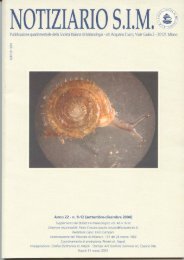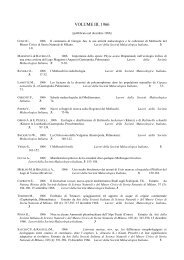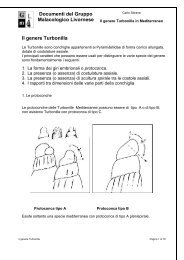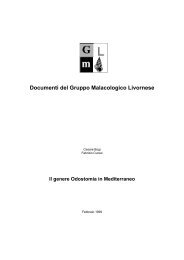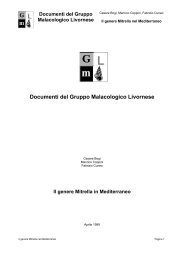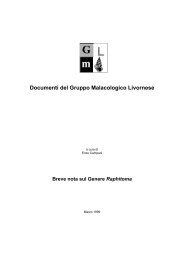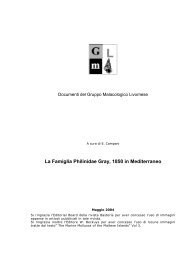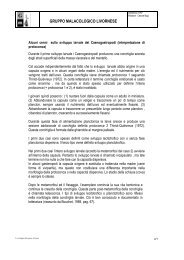scarica il Notiziario S.I.M. - SocietàItaliana di Malacologia
scarica il Notiziario S.I.M. - SocietàItaliana di Malacologia
scarica il Notiziario S.I.M. - SocietàItaliana di Malacologia
- No tags were found...
Create successful ePaper yourself
Turn your PDF publications into a flip-book with our unique Google optimized e-Paper software.
in un’area compresa tra l’alta Valle Trompia e la ValleSabbia e in una stazione isolata presso <strong>il</strong> Monte Tremalzo,sulla sponda nord-occidentale del Lago <strong>di</strong> Garda, alconfine tra le province <strong>di</strong> Brescia e Trento. L’articolo vienecompletato da una lista annotata <strong>di</strong> tutti i Claus<strong>il</strong>iidaesino ad oggi conosciuti per la regione Lombar<strong>di</strong>a.Molluschi foss<strong>il</strong>iManganelli G., Martini I. & Benocci A., 2011. A newJanulus species (Gastropoda, Pulmonata, Gastrodontidae)from the Zanclean (early Pliocene) of Tuscany (centralItaly). Bollettino della Società Paleontologica <strong>Italiana</strong>, 50(3): 165-173.Janulus spa<strong>di</strong>ni n. sp. (Gastropoda, Pulmonata, Gastrodontidae)is descrive herein from the Zanclean (early Pliocene) ofBalze <strong>di</strong> Caspreno (Tuscany). It belongs to a Macorenesian genusoccasionally reported from the Tertiary of Europe. The newspecies is very sim<strong>il</strong>ar to the recent Madeiran Janulus stephanophorusby virtue of its shape, dorsal sculpture and ra<strong>di</strong>alrows of palatal teeth. It is also apparently sim<strong>il</strong>ar to some foss<strong>il</strong>European species, however, due to insufficient information regar<strong>di</strong>ngthe latter, no well supported <strong>di</strong>stinction may be proposedat present. A brief survey of all the nominal taxa of thespecies-group assigned to Janulus is also provided.[Una nuova specie <strong>di</strong> Janulus (Gastropoda, Pulmonata,Gastrodontidae) dal Pliocene inferiore della Toscana(Italia centrale)] Janulus spa<strong>di</strong>ni n. sp. è descritto sulla base<strong>di</strong> materiale raccolto nelle arg<strong>il</strong>le continentali del Plioceneinferiore delle Balze <strong>di</strong> Caspreno (Toscana). La nuovaspecie appartiene ad un genere attualmente esclusivodella Macaronesia, ma conosciuto per <strong>il</strong> Terziario europeo.Janulus spa<strong>di</strong>ni n. sp. è molto sim<strong>il</strong>e a Janulus stephanophorus,una specie vivente a Madeira (le due speciecon<strong>di</strong>vidono: forma, scultura dorsale e f<strong>il</strong>e ra<strong>di</strong>ali <strong>di</strong>denti palatali) ma ricorda anche alcune entità descritteper <strong>il</strong> Terziario europeo. Una <strong>di</strong>fferenziazione adeguatarispetto a questi taxa è al momento impossib<strong>il</strong>e, mancandodel tutto informazioni sulla struttura dei loro dentipalatali. Conclude <strong>il</strong> lavoro l’elenco <strong>di</strong> tutti i taxa nominaliassegnati a Janulus, inclusivo <strong>di</strong> una breve <strong>di</strong>scussionesul loro status.Taviani M., Angeletti L., & Ceregato A., 2011. Chemosyntheticbivalves of the fam<strong>il</strong>y Solemyidae (Bivalvia,Protobranchia) in the Neogene of the me<strong>di</strong>terranean basin.Journal of Paleontology, 85 (6): 1067–1076, The PaleontologicalSociety 0022-3360/11/0085-1067$03.00The Me<strong>di</strong>terranean area is the locus of a variety of deep-seachemosynthetic environments that have been exploited by bivalvesof the fam<strong>il</strong>y Solemyidae during Cenozoic to presenttime. Large solemyids represented by the Solemya doderleinigroup were widely <strong>di</strong>stributed in Neogene deep-sea reducinghabitats, inclu<strong>di</strong>ng cold vent hydrocarbon sites. Based uponthe <strong>di</strong>agnostic structure of the ligament, Solemya doderleini(Mayer), 1861 and S. subquadrata (Foresti), 1879 are movedto the genus Acharax Dall, 1908. After the Messinian SalinityCrisis Acharax doderleini re-colonized deep-sea sulphideenvironments up to the Pliocene at least. At present, Acharaxoccurs in sim<strong>il</strong>ar settings in the adjacent eastern AtlanticOcean. Thus far, large solemyids are not documented from thepresent deep Me<strong>di</strong>terranean Sea in spite of a vast number ofseep and reducing habitats with chemosynthetic biota, especiallyconcentrated in its Eastern basin. Promisingly, however,a single live juven<strong>il</strong>e specimen of Solemyidae has been recentlyfound at bathyal depth associated with a pockmark in the N<strong>il</strong>eDeep Sea Fan.L’area del Me<strong>di</strong>terraneo è <strong>il</strong> locus <strong>di</strong> una varietà <strong>di</strong> ambientichemiosintetici profon<strong>di</strong> colonizzati da bivalvidella famiglia Solemyidae dal Cenozoico ad oggi. Solemyi<strong>di</strong><strong>di</strong> gran<strong>di</strong> <strong>di</strong>mensioni rappresentati dal gruppoSolemya doderleini si <strong>di</strong>ffusero largamente negli habitatprofon<strong>di</strong> e riducenti del Neogene, compresi i siti <strong>di</strong> emissionefredda <strong>di</strong> idrocarburi (i “cold vent”). Sulla base dellastruttura del legamento, <strong>di</strong> valore <strong>di</strong>agnostico, Solemyadoderleini (Mayer), 1861 e S. subquadrata (Foresti), 1879vengono attribuite al genere Acharax Dall, 1908. Dopo laCrisi <strong>di</strong> Salinità del Me<strong>di</strong>terraneo, Acharax doderleini ricolonizzògli ambienti profon<strong>di</strong> ricchi <strong>di</strong> solfuri, almenofino al Pliocene. Attualmente Acharax è presente in contestisim<strong>il</strong>i nell’a<strong>di</strong>acente Atlantico orientale. Fino a questomomento, non sono documentati solemyi<strong>di</strong> <strong>di</strong> gran<strong>di</strong> <strong>di</strong>mensioninel Me<strong>di</strong>terraneo profondo, malgrado un grannumero <strong>di</strong> aree <strong>di</strong> emissione <strong>di</strong> flui<strong>di</strong> e <strong>di</strong> habitat riducenticon biota chemiosintetici, particolarmente concentratinel suo bacino orientale. Risulta promettente comunqueun singolo in<strong>di</strong>viduo giovan<strong>il</strong>e <strong>di</strong> Solemyidaescoperto recentemente a profon<strong>di</strong>tà batiali, associato adun pockmark ai pie<strong>di</strong> della conoide del N<strong>il</strong>o.Tabanelli C., Bongiar<strong>di</strong>no C. & Perugia I., 2011. Cingulopsidaee Rissoidae pliocenici provenienti dallo“spungone” (Pedeappenino romagnolo) e loro eventualesignificato paleoambientale. Quaderno <strong>di</strong> Stu<strong>di</strong> e Notizie <strong>di</strong>Storia Naturale della Romagna, 32: 27-76.Gli autori prendono in esame 29 specie, una ascrivib<strong>il</strong>ealla famiglia Cingulopsidae e le altre alla famiglia Rissoidae.Quattro specie, appartenenti al genere Alvania Risso,1826, vengono proposte come nuove. Il materiale stu<strong>di</strong>atoproviene da quattro siti <strong>di</strong> età piacenziana facentiparte <strong>di</strong> un complesso <strong>di</strong> calcari organogeni conosciutocon <strong>il</strong> nome <strong>di</strong> “spungone”. Tutti i reperti sono alloctonie riferib<strong>il</strong>i per lo più a biocenosi della piattaforma continentale.The authors esamine 29 taxa of species from organogenic arenitesof Piacenzian age, part of a se<strong>di</strong>mentary complex known as“spungone”. The material stu<strong>di</strong>ed comes from 4 sites wherethe foss<strong>il</strong> association consists of elements carried from severalbiotic communities. Four species are proposed as new.Segnalazioni bibliografiche13



